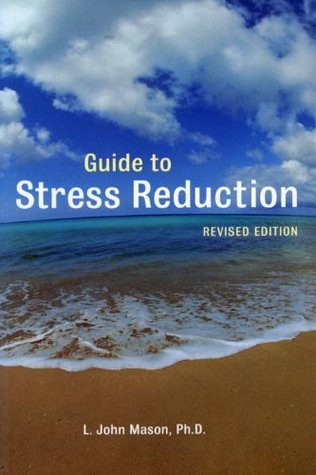Guide to Stress Reduction Summary
4 min read ⌚
 Modern times present the perfect gift for you – stress and worry. You are probably just one another victim of this silent killer.
Modern times present the perfect gift for you – stress and worry. You are probably just one another victim of this silent killer.
Why is stress unhealthy? How can you convince yourself that it is necessary? What are some techniques you can use to relieve stress during turbulent times?
Find the answers in our “Guide to Stress Reduction” Summary, and finally learn to chill out.
Who Should Read “Guide to Stress Reduction”? and Why?
“Guide to Stress Reduction” is a bestseller that is being continually reprinted for more than 20 years. The author persuasively presents his opinion that stress is an unhealthy part of the modern world. Furthermore, apart from theoretically explaining why stress is wrong for humans, he lists techniques for learning how to deal with unwanted anxiety.
This book is a practical guide recommended for everyone who would want to reduce the stress levels in their lives. Moreover, who would not want to become more chill and carefree?
About L. John Mason
 John Mason is a stress management and biofeedback therapy consultant since 1977. Moreover, he is an executive coach and lecturer on the subject.
John Mason is a stress management and biofeedback therapy consultant since 1977. Moreover, he is an executive coach and lecturer on the subject.
“Guide to Stress Reduction Summary”
Stress is an indivisible part of our being.
Our ancestors needed to stress over turning into some animal’s meal and thus had to stay alert for each movement and sound in their environment. Stress developed as a reaction to help them either flee from the reason for their anxiety or fight it.
Nowadays, we think we should live with stress and acknowledge it as a piece of our current life. Tragically, we do not see the negative consequences it has on our wellbeing until the point that it is past the point of no return.
On the off chance that you experience regular migraines, aches, and sleeping disorders, yet your specialist has confirmed you do not have a medicinal condition, you are the perfect subject for stress reduction. Note that many individuals have reduced anxiety and its physical reactions by utilizing the techniques we will mention.
Everybody needs some portion of stress to motivate them, and little stress can prove to be productive. However, accepting stress for a specific short-term reason is altogether different from tolerating undesirable worries as a consistent piece of your life.
Contrary to popular belief, medications do not kill stress; they merely veil its symptoms. Indeed, you cannot always stay away from stress, but you can work on decreasing its power. Work on fixing the anxiety, and you will not need the medications.
The question is how?
The most critical and most straightforward unwinding strategy is to learn how to breathe correctly. Slow, deep breathing can slow down your heart rate and enable your blood pressure fall.
Now, let’s do a simple exercise, shall we?
Put your hand just underneath your breastplate, but above your stomach, so you can check how deep your breaths are. Keep your hand in place as you breathe normally.
Does your hand move?
If not, your breaths are not deep enough: to breathe deeper, you need to utilize your diaphragm to get air to the base of your lungs. Only this sort of breathing can bring you the feeling of relaxation.
Furthermore, the power of positive thinking through visual symbolism has for quite some time been perceived as a strategy for battling mental or physiological problems. Envision yourself as a peaceful and stress-free person, and you will soon become one. You can utilize this technique to deal with unwanted worries in your life.
Of course, these are only the basics. For more techniques and tips, immerse yourself into “Guide to Stress Reduction.” And now, we will continue with a few other lessons you may expect to learn.
So, stay with us.
Key Lessons from “Guide to Stress Reduction”:
1. Altered States: Meditation
2. Desensitization
3. Stress at Work
Altered States: Meditation
A wide range of schools of the act of meditation falls into general groupings. Transcendental meditation is the most significant group that tries to modify your mental state and free energy flows. The objective of meditation is to permit a focus of attention in a way that isn’t conceivable in typical everyday life. Zen meditation, on the other hand, tries to raise a feeling of mindfulness and is possible even while working out. In both strategies, however, proper breathing is vital.
Desensitization
Professional therapists utilize a few techniques for anxious patients. If you realize that even playing out specific activities influences you to feel tense and squeamish, employ these methods to help you desensitize. Envision experiencing the distressing event. Next, meditate on experiencing the steps one by one and taking care of them well. When you get to a point where you feel on edge, stop and utilize your favorite unwinding technique. Afterward, begin again and check whether you can get further. In the long run, you will have the capacity to deal with the entire sequence of steps.
Stress at Work
Rapid change is the standard in the working environment nowadays. Deal with your circumstances proactively, if you are forced to bear the changes. Being fit and healthy encourages you to remain strong, regardless of the pressures of the unknown waters. Keep your alternatives open and speak with the individuals who can open new doors for you.
Like this summary? We’d Like to invite you to download our free 12 min app, for more amazing summaries and audiobooks.
“Guide to Stress Reduction” Quotes
Everywhere you go there are people holding tension in their skeletal muscles and wearing stress on their faces. Click To Tweet
Since you cannot avoid the stress of change and don’t want to isolate yourself from positive change, you must learn to control the way you respond to these new situations. Click To Tweet Stress reduction practiced on a regular basis can help prevent, modify or eliminate the sources and symptoms of your physical complaints. Click To Tweet Habits and fears can be changed or reversed if you visualize the desired behavior. Click To Tweet Relaxation does not mean that you are numb or out of touch with your body – it means that you are more aware and more in touch with yourself, other people and your environment. Click To TweetOur Critical Review
John Mason has a compelling writing style and presents relaxing techniques which are practical and useful. On the other hand, part of the medical claims about the positive effects of reduced stress is less convincing. However, anyone could use a way to deal with unwanted worries at some point in life or another. The benefits do not need to be countless. Becoming happier is enough.
Emir is the Head of Marketing at 12min. In his spare time, he loves to meditate and play soccer.







